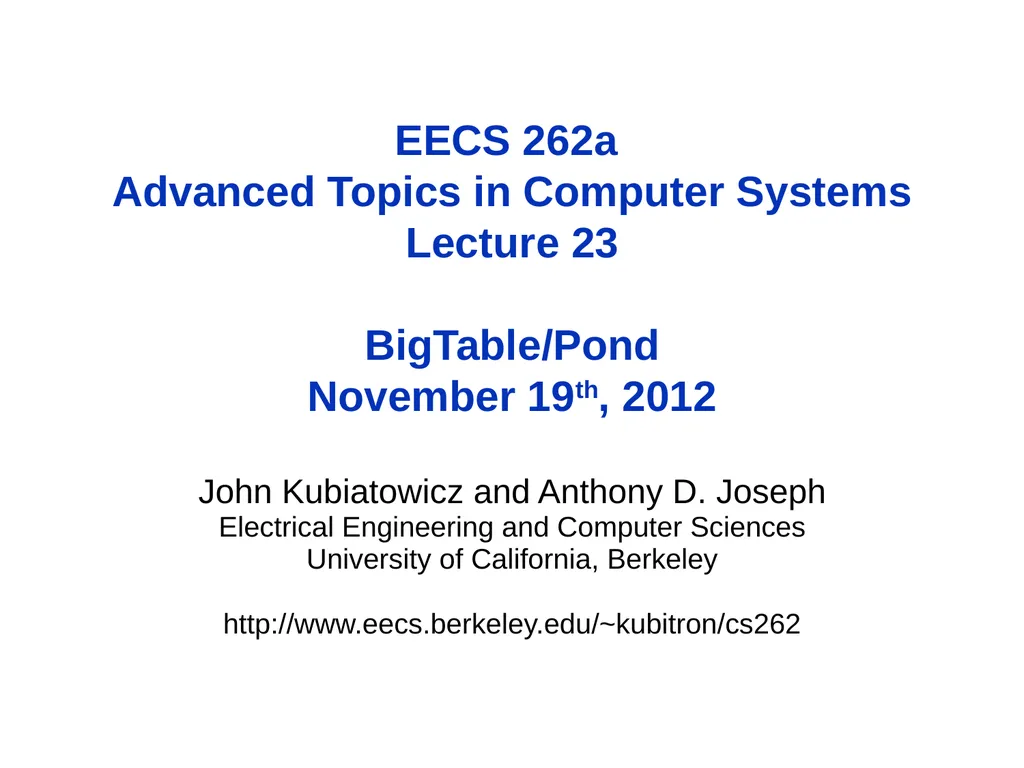EECS 262a Advanced Topics in Computer Systems
Author : calandra-battersby | Published Date : 2025-06-23
Description: EECS 262a Advanced Topics in Computer Systems Lecture 23 BigTablePond November 19th 2012 John Kubiatowicz and Anthony D Joseph Electrical Engineering and Computer Sciences University of California Berkeley
Presentation Embed Code
Download Presentation
Download
Presentation The PPT/PDF document
"EECS 262a Advanced Topics in Computer Systems" is the property of its rightful owner.
Permission is granted to download and print the materials on this website for personal, non-commercial use only,
and to display it on your personal computer provided you do not modify the materials and that you retain all
copyright notices contained in the materials. By downloading content from our website, you accept the terms of
this agreement.
Transcript:EECS 262a Advanced Topics in Computer Systems:
EECS 262a Advanced Topics in Computer Systems Lecture 23 BigTable/Pond November 19th, 2012 John Kubiatowicz and Anthony D. Joseph Electrical Engineering and Computer Sciences University of California, Berkeley http://www.eecs.berkeley.edu/~kubitron/cs262 Today’s Papers Bigtable: a distributed storage system for structured data. Appears in Proceedings of the 7th Conference on USENIX Symposium on Operating Systems Design and Implementation (OSDI), 2006 Pond: the OceanStore Prototype. Appears in Proceedings of the 2nd USENIX Conference on File and Storage Technologies (FAST), 2003 Thoughts? BigTable Distributed storage system for managing structured data Designed to scale to a very large size Petabytes of data across thousands of servers Highly-available, reliable, flexible, high-performance solution for all of Google’s products Hugely successful within Google Web indexing, Personalized Search, Google Earth, Google Analytics, Google Finance, … Motivation Lots of (semi-)structured data at Google URLs: Contents, crawl metadata, links, anchors, pagerank, … Per-user data: User preference settings, recent queries/search results, … Geographic locations: Physical entities (shops, restaurants, etc.), roads, satellite image data, user annotations, … Big Data scale Billions of URLs, many versions/page (~20K/version) Hundreds of millions of users, thousands or q/sec 100TB+ of satellite image data What about a Parallel DBMS? Data is too large scale! Simpler and sparse data model Using a commercial approach would be too expensive Building internally means system can be applied across many projects for low incremental cost Low-level storage optimizations significantly improve performance Difficult to do when running on a DBMS Goals A general-purpose data-center storage system Asynchronous processes continuously updating different pieces of data Access most current data at any time Examine changing data (e.g., multiple web page crawls) Need to support: Durability, high availability, and very large scale Big or little objects Very high read/write rates (millions of ops per second) Ordered keys and notion of locality Efficient scans over all or interesting subsets of data Efficient joins of large one-to-one and one-to-many datasets BigTable Distributed multi-level map Fault-tolerant, persistent Scalable Thousands of servers Terabytes of in-memory data Petabyte of disk-based data Millions of reads/writes per second, efficient scans Self-managing Servers can be added/removed dynamically Servers adjust to load imbalance Building Blocks Building blocks: Google File System (GFS): Raw storage Scheduler: schedules jobs onto machines Lock service: distributed lock manager MapReduce: simplified large-scale data processing BigTable uses of building blocks: GFS: stores persistent data (SSTable file format for storage of data) Scheduler: schedules jobs involved in BigTable serving Lock service: master election, location














